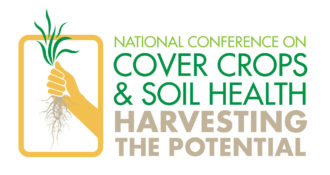Session recordings on this page include:
- Opening remarks by Jane Hardisty (USDA-NRCS Indiana) with video message by Bill Northey (Iowa Secretary of Agriculture)
- Keynote: Growing a Revolution - Bringing Our Soil Back to Life, by David Montgomery (University of Washington)
- Farmer panel: Experiences with Cover Crops and Soil Health, with Dan DeSutter (Ind.), Trey Hill (Md.) and Jimmy Emmons (Okla.)
- Top 10 Ways Cover Crops Build Soil Health, by Rob Myers (North Central SARE)
- Plenary session: Carbonomics, by Keith Berns (Neb. farmer and Green Cover Seed)
Opening Remarks
Jane Hardisty (USDA-NRCS Indiana) and Bill Northey, Iowa Secretary of Agriculture
Keynote: Growing a Revolution - Bringing Our Soil Back to Life
David Montgomery, University of Washington
One of the key lessons of history is as simple as it is stark: where the soil became degraded, communities and even whole countries failed and disappeared. Visits to farmers around the world show how innovative farmers combining farming practices from the past with modern science are at the vanguard of a soil health revolution that could reverse the ancient trend and bring humanity’s ailing soil back to life remarkably fast. Combining previously popular practices of cover crops and diversified crop rotations with modern methods of no-till planting cultivates beneficial soil life and allows using less production costs, such as less diesel, fertilizers, or pesticides. These practices are good for farmers and the environment. Regenerative practices that build soil organic matter translate into farms that use less water, have less soil and nutrient loss, and build soil organic matter while using less fossil fuel to maintain crop yields, build soil health, and improve farmers’ bottom lines.
Farmer panel: Experiences with Cover Crops and Soil Health
Dan DeSutter (Ind.), Trey Hill (Md.) and Jimmy Emmons (Okla.)
Participants will have the opportunity to hear from three of the leading innovators in their respective regions on the use of cover crops and soil health practices. These farmers have been using cover crops and notill for many years, and they will share some of their experiences in trying new approaches to improving soil health, and the impact these practices have had on their soil and achieving their overall farm goals. Emmons and DeSutter also have livestock and will talk about the integration of cattle into their operations.
Top 10 Ways Cover Crops Build Soil Health
Rob Myers, North Central SARE (PDF)
This presentation will cover the top 10 ways that cover crops can improve soil health. More specifically, information will be provided on how cover crops affect soil biology, organic matter, physical and chemical properties, and overall health. Examples include the role of cover crops with nutrient dynamics, biodiversity, soil aeration and structure, and soil carbon. Connections between crops, livestock, and soil health will be discussed as well how other management practices relate to cover crops and soil health.
Plenary session: Carbonomics
Keith Berns, Neb. farmer and Green Cover Seed
A unique approach to looking at the big picture of soil health by comparing the economy of a country to the underground economy of the soil. The complex relationship between plants, soil, and biology and how they are interconnected and interdependent will be discussed. Economic fundamentals of supply, demand, currency, capital, energy, resources, infrastructure, and defense will be applied to the bustling subterranean economy of a healthy soil system. The role of carbon as the currency that facilitates interactions between plants, soil, and biology in this system will be discussed.
The following session recordings are available:
